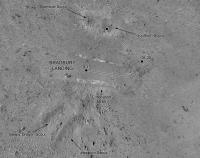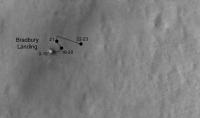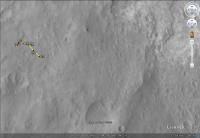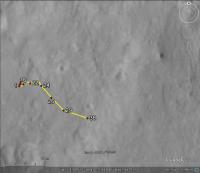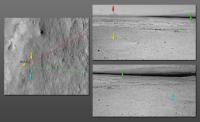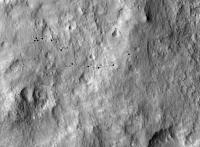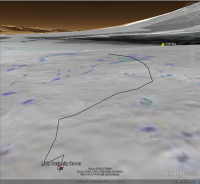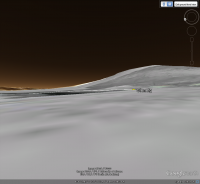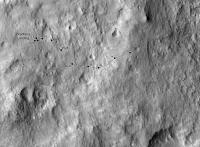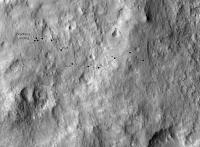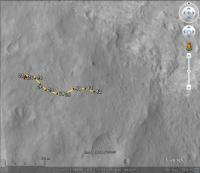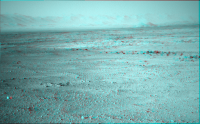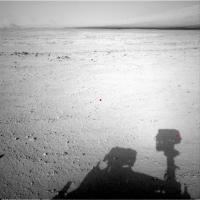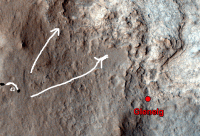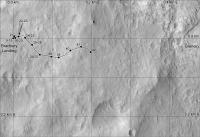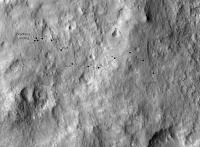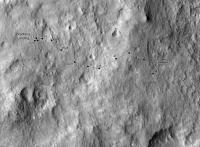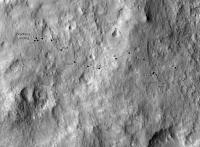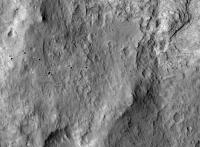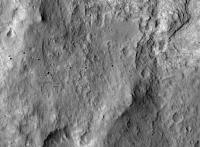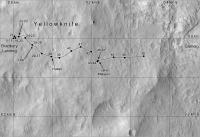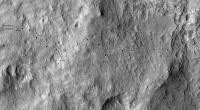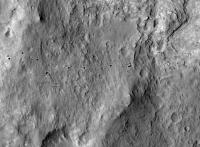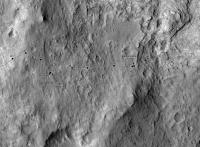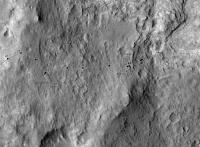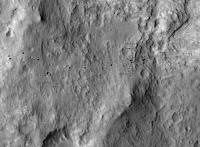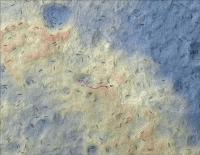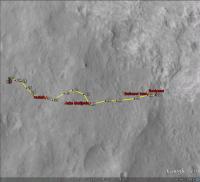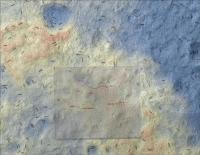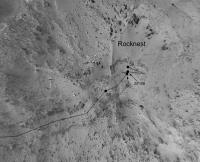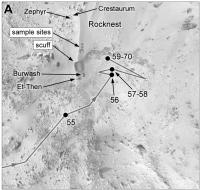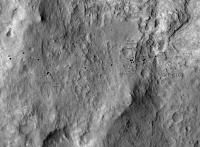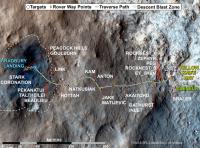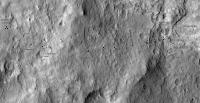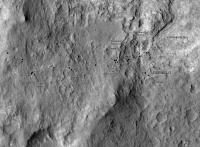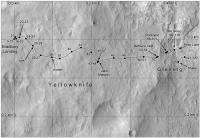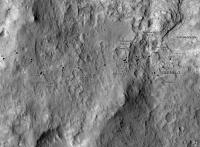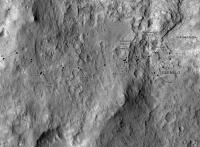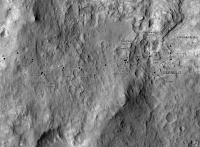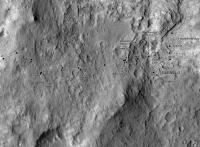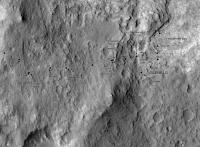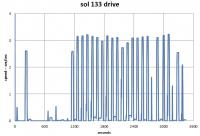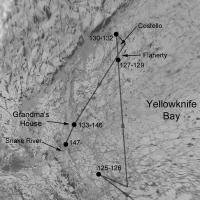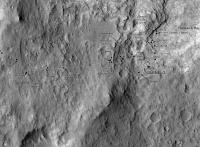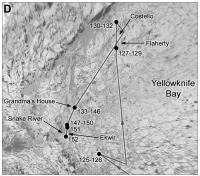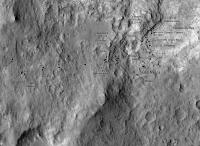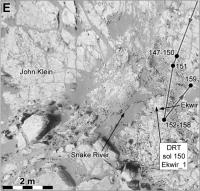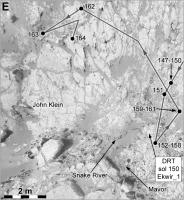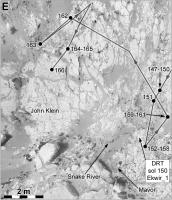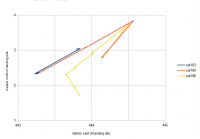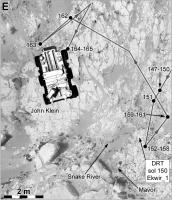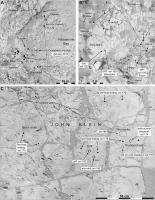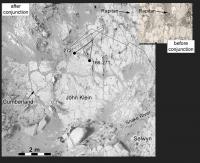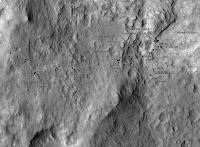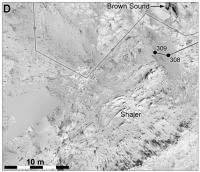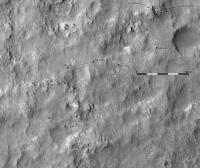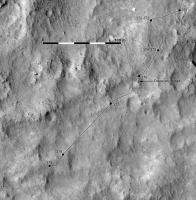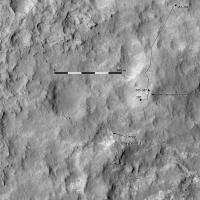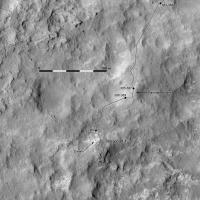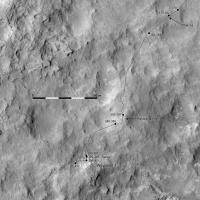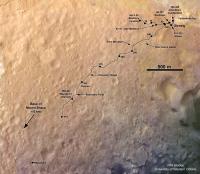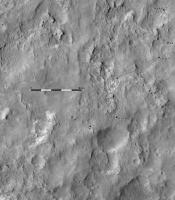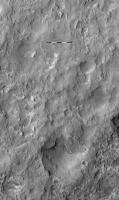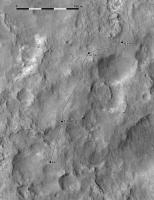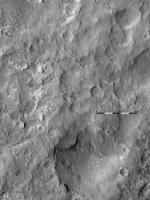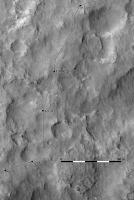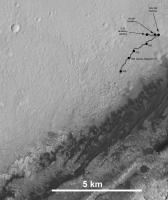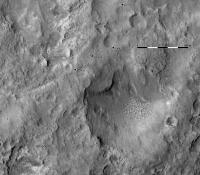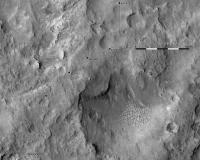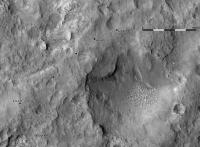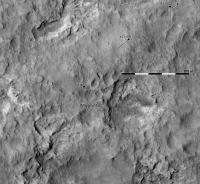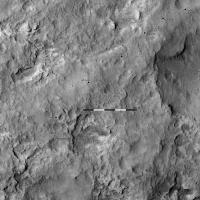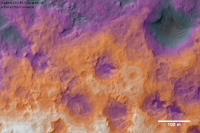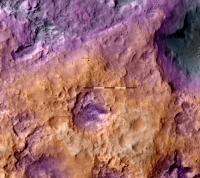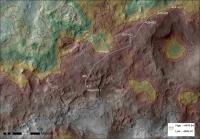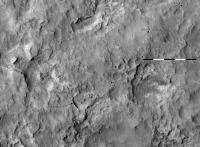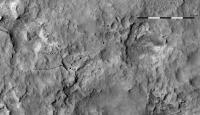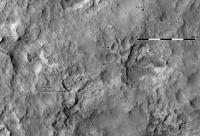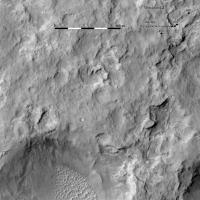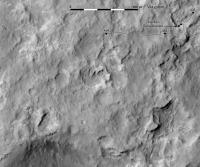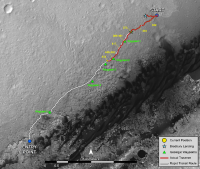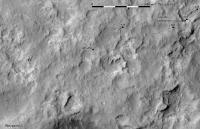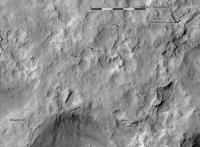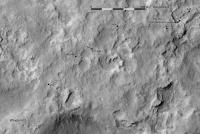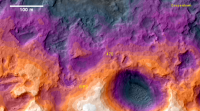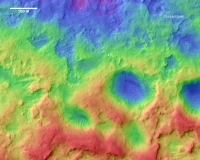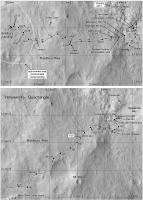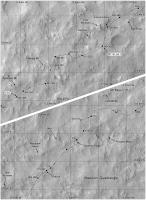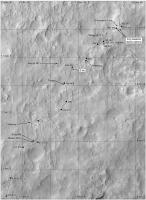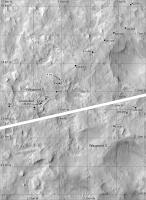Printable Version of Topic
Click here to view this topic in its original format
Unmanned Spaceflight.com _ MSL _ MSL Route Map
Posted by: Phil Stooke Aug 29 2012, 08:52 PM
Thread created for posting MSL route maps and map updates.
Comments / suggestions adding value to the route maps are allowed, but discussions regarding the route itself and "future" paths are not. Use the currently active thread for the latter.
Eduardo Tesheiner
Moderator
-----
Here's an updated map of activities near the landing site and the start of a map of the route to Glenelg. I may get one more step added to this before I have to take a break Aug. 31 to Sept 16, and I will resume it after that. Details will be revised as necessary as we go.
Phil
Posted by: Phil Stooke Aug 30 2012, 08:52 PM
I would just like to add - don't necessarily think of this as 'my' thread. I would be delighted to see other visualizations of the route, topo maps and other base maps from anyone else (not representations of future routes, but certainly other ways to visualize what has been done).
And to repeat something i said on the previous thread, I am forced to take a break from this from now until 16 September. I will update on the 17th or as soon as possible after that, and then frequently after that.
Phil
Posted by: nprev Aug 30 2012, 08:59 PM
Copy that, Phil! ![]()
Course tracing plots from everyone are of course welcome, and all I can say is please follow Eduardo's guidance in the first post of this thread. This is to be our one-stop source for MSL's position on the surface as Eduardo so generously has done for the MERs.
I'll just be the evil robot lurking around...watching... ![]()
Posted by: elakdawalla Aug 30 2012, 10:36 PM
While I will not be able to reliably update a route map, I'd be interested in contributing by creating carefully scaled photographic base maps on which other members of the community could help by plotting points, and providing a place for those to live on planetary.org. However, I'm not quite sure how to do this in a way that others will be able to use. If I were doing this by myself, I'd make the maps in Adobe Illustrator, but I suspect I'm one of the few people here who uses it or has access to it. I can save Illustrator files as editable PDFs, or as EPS files -- if I did it that way, would others be able to contribute by adding points and segments using whatever software you have access to? I would insist on doing it in some piece of vector graphics software so that the maps could be scaled.
Posted by: Pando Aug 30 2012, 10:55 PM
Emily, how about using Google Mars KML? It can be edited as a file and posted here as an attachment, and you could update it periodically in the planetary.org site.
However, I don't know how accurate the current imagery at Google Mars is.
Just a thought.
Posted by: Tesheiner Aug 31 2012, 06:53 AM
I had to deal with this problem when I took the decision to create the KMLs for Opportunity. I wanted to avoid the need to update each and every position plot on the route overlay in case of an update to the map background e.g. in case a more accurate one was provided -- remember when we were creating the tiles to cover the ground up to Endeavour? --
What I did and still do is to keep all the rover positions registered in (x, y) coordinates to a reference HiRISE image. When creating the KML layer, the process automatically converts those ones to lat / long with the help of some "control points" (e.g. bright patches, little craters) I chose near the route path. If the GE background changes I only need to adjust the lat / long of those control points and re-run the KML generation process. This method was *very* helpful when the maps at Opportunity site were updated by NASA / AMES. Remember the two versions of KML files I kept some time ago?
Posted by: elakdawalla Aug 31 2012, 03:10 PM
That makes sense. How did you do that? Is your route map simply a spreadsheet of X,Y locations in pixels that you convert into KML language?
Posted by: Tesheiner Aug 31 2012, 05:05 PM
Well, it's more than that. ![]()
But, yes, one of the columns is the (x, y) position on a reference map. Those are "automagically" converted to lat / long (another column) and the whole spreadsheet is parsed by a VB macro which creates the KML file.
Just testing... ![]()
 Route_Map_Sol22.kml ( 2.32K )
: 3750
Route_Map_Sol22.kml ( 2.32K )
: 3750
Posted by: Tesheiner Aug 31 2012, 06:36 PM
Still testing... now with sol 24. Route_Map_Sol24.kml ( 2.57K )
: 4350
Route_Map_Sol24.kml ( 2.57K )
: 4350
Posted by: Cruzeiro do Sul Aug 31 2012, 08:23 PM
Hy Tesheiner. I used to follow your updates of Opportunity route maps for years now. I find them fascinating and very easy to consult with the "grid" that allow us to compare the distances between each drive, much more than Google Mars KLM's. Forgive me to be unaware on this, but what you need to do such maps for the Curiosity journey?
Posted by: Doc Aug 31 2012, 08:46 PM
Looks good for a test Tesheiner.
Posted by: Tesheiner Sep 1 2012, 07:12 AM
A good image of the terrain (http://www.unmannedspaceflight.com/index.php?s=&showtopic=7413&view=findpost&p=190357may be a good one) and spare time to setup the photoshop like environment.
Patience, my little grasshopper.
Posted by: Cruzeiro do Sul Sep 1 2012, 02:48 PM
Ok, thanks! I wonder if you would need some autorisation from JPL or something like this to uses some maps that they made. Insteed, I understand that you do all this stuff all by yourself Congratulations, it's a great job...which need TIME. Maybe you can take some holidays on Mars for to have some extra 38 minutes each day to do so. ![]()
Posted by: Tesheiner Sep 6 2012, 08:07 PM
I was a little bit lost after the two latest drives (sols 26 and 29) but http://www.unmannedspaceflight.com/index.php?s=&showtopic=7454&view=findpost&p=190748 pointing to the HiRISE picture taken of the rover tracks just made my day.
Here's an updated route map for Google Earth.
 Route_Map_Sol29.kml ( 2.96K )
: 3941
Route_Map_Sol29.kml ( 2.96K )
: 3941Posted by: Doc Sep 6 2012, 11:00 PM
Glad to hear I was not alone
Posted by: verfkwast Sep 7 2012, 03:46 PM
5 Sol 26 pictures in Google Earth Mars.......
- All MSL Components +Rover tracks in Gale crater
- .

- Sol 26 + Rover tracks
.
Google Earth KMZ file....
Posted by: Ondaweb Sep 7 2012, 04:13 PM
VW, Thanks for that KML. Nothing I've seen better provides all the familiar images in their appropriate contexts. Very helpful to see just where everything is.
Posted by: Tesheiner Sep 7 2012, 06:16 PM
Wow! I really, really, like it.
And welcome to UMSF, verfkwast.
Posted by: Doc Sep 7 2012, 06:18 PM
Here here! Excellent work verfkwast.
Posted by: CosmicRocker Sep 8 2012, 04:31 AM
I like it.
Posted by: verfkwast Sep 8 2012, 04:34 PM
.
Update Googlle earth Rover overlays
MSL Components +Rover tracks in Gale crater.......
All 5 images placed + ballast

Posted by: verfkwast Sep 10 2012, 12:32 AM
.
for who wants more ...
Here's the 1st Full Crater Map for Google Earth
it makes Google Mars a great tool to have some fun with Gale Crater
.
- http://www.valkvideos.nl/3dgooglemaps/googlepromo_gr.jpg
needs 2 gb memory
& 600 mb diskspace
Update 12/9: Easy install
.
Posted by: gregson Sep 10 2012, 08:26 PM
Downloaded. The pixel size is about 10m.
Posted by: sattrackpro Sep 10 2012, 11:01 PM
Hi Tesh - it's been a long time since I have been able to visit here - and so glad to see that you're keeping up a good route-map! As usual.
I'll be looking forward to your latest update on where this new rover is. Thanks much!
I'm waaaay behind on the new interface, so hope my first post in years 'makes it'...
Posted by: Tesheiner Sep 15 2012, 08:54 AM
Here's my attempt at locating MSL on sol 38.
 Route_Map_Sol38.kmz ( 1.05K )
: 2210
Route_Map_Sol38.kmz ( 1.05K )
: 2210Posted by: markril Sep 17 2012, 04:03 PM
I'll take a stab at Sol 41 based on the latest Navcams:
And a thumbtack:
 Sol_41.kmz ( 720bytes )
: 2115
Sol_41.kmz ( 720bytes )
: 2115Hopefully, I got it right...
Mark
Posted by: Phil Stooke Sep 17 2012, 08:42 PM
Route map update...
I am fairly happy with all locations except the last one, which is very preliminary - originally I had it further south but I like Markril's estimate. All features of the map may be updated retroactively from time to time.
Phil
EDIT:
Looks like the last drive should be a bit shorter, and the one before a bit longer... I will be adding a scaled grid to this later.
Posted by: akuo Sep 18 2012, 05:43 AM
Thanks guys for the mapping effort. As I said in the other thread, the limited amount of available full resolution navcams all around the rover must make mapping challenging.
Posted by: jmknapp Sep 18 2012, 12:00 PM
I put that track into Google Earth--here's the overall view of the track as seen from a point about 25 meters above the landing spot:
Even from that vantage, Glenelg is slightly below the horizon. The ground image is the slope map. The track appears to go through some rougher terrain, so maybe it went around that a bit? Green is 12.5°-25° slope (no traverse on sand, some slip on bedrock).
Here's the ground-level view from the terminal point:
The pushpin for Glenelg is just peeking over the rise, so maybe it's not quite visible yet? GE elevation is based on MOLA and the "ground level" observation point in this case is from a height of 1.75 meters.
Beeline range to Glenelg is about 190 meters, 170 meters to the landing site.
KMZ file:
 t40.kmz ( 1.46K )
: 2074
t40.kmz ( 1.46K )
: 2074Posted by: Phil Stooke Sep 18 2012, 02:11 PM
Revised route map for sol 41 - I had to revise the sol 40 point, which was difficult to match with HiRISE.
Phil
Posted by: markril Sep 18 2012, 05:57 PM
Here's an estimate for Sol 42. It's easier to identify some of these ground features when viewing in 3D.
 Sol_42.kmz ( 1.1K )
: 2122
Sol_42.kmz ( 1.1K )
: 2122Mark
Posted by: Hanno Sep 18 2012, 08:09 PM
Could you add a scale bar to the route map? That would be really helpful in understanding it. ![]()
Posted by: Doc Sep 18 2012, 08:27 PM
Not to worry Hanno, Phil has promised that. BTW welcome to UMSF.com seeing it is your first post!
Posted by: Phil Stooke Sep 18 2012, 08:44 PM
I'll get to it, but it helps to recall from the JPL news updates that the longer drive segments are generally about 30-35 m long.
My intention is to work on these maps at a standard scale with a 100 m grid superimposed. For areas with a lot of activity in a small area I will make more detailed maps at a larger scale, with a scale bar. The current map is between the two scales and I'm working on a different version for later, but right now I want to keep using this high contrast enlarged HiRISE base.
Phil
Posted by: dvandorn Sep 18 2012, 08:51 PM
I know I have been assuming standard map orientation with North up, West to the left, etc., etc. Assuming the HiRISE image was taken in the afternoon, that would be consistent with the lighting.
Obviously, if we need to slew a map around for ease of demonstrating a particular route (as I can imagine may be needful when we get around to things like driving up a drywash cut canyonlike into the lower mound), it would be nice to see a compass rose somewhere, just for general orientation... and to help people like me find things when someone says "it's just west of the Sol 24 position." ![]()
-the other Doug
Posted by: Tesheiner Sep 18 2012, 10:25 PM
Here's my version of route map for Google Earth / Mars.
 Route_Map_Sol42.kmz ( 1.16K )
: 2087
Route_Map_Sol42.kmz ( 1.16K )
: 2087Phil, slight differences on the sol locations aside, I see that the route on your map have a rotation of a few degrees (five?) when compared to mine and the same happens to the HiRISE background. I'm using the map-projected version of http://hirise.lpl.arizona.edu/ESP_028401_1755 as a reference to register the polar mosaics and which is presumed to have North up. What do you think?
Posted by: Phil Stooke Sep 18 2012, 10:32 PM
I'm using a map-projected image as well, but a pre-landing one chosen to be almost vertical (I don't have the file name with me right now). The incidence angle might cause an apparent rotation on sloping ground. And map projection might be based on a different central meridian or based on a preliminary ephemeris.
Phil
Posted by: stewjack Sep 18 2012, 10:52 PM
Mark
Definitly true in my case, once I created a Anaglyph and compared it to Marks visual explanation. (see below)
http://www.unmannedspaceflight.com/index.php?act=attach&type=post&id=28176
I hope this down and dirty Anaglyph provides some context for other people.
What I am not certain about is that this view is toward the NE. Also that mid distance could be described as a view of the northern portion of Glenelg. If I was a sailor I would describe my method as dead reckoning. I am not going to have time for much else. Back when Spirit was climbing Husband Hill I dead reckoned myself down and about 50 meters back out onto the plains before I was totally convinced I was completely lost!
Jack
EDIT Changed SE to NE.
Thank you markril!
Posted by: markril Sep 18 2012, 11:22 PM
FWIW, I've been using the orthoimages from this DTM page:
http://hirise.lpl.arizona.edu/dtm/dtm.php?ID=PSP_010573_1755
Specifically:
PSP_010573_1755_RED_A_01_ORTHO
PSP_010639_1755_RED_A_01_ORTHO
They are map-projected, but are also adjusted using the DTM data to be a view looking directly down.
Mark
P.S. Jack, that view is looking NE... ![]()
Posted by: jmknapp Sep 19 2012, 12:29 AM
Could rover shadows be used to get a rough fix? For example this shot:
http://mars.jpl.nasa.gov/msl/multimedia/raw/?rawid=NRA_401232925EDR_F0041632NCAM00427M_&s=42
NASA does mark the UTC time of the shots (one of the few bits of shooting conditions given), in this case 2012-09-18 09:38:11 UTC. An ephemeris program shows that the sun at the MSL site at that time was at 25.1° elevation and 275.1° azimuth, so the shadow of a vertical gnomon would be at 95°. Here's the image with the camera boresight and the approximate location of the right navcam shadow marked with red dots:
The separation between the dots is 392 pixels horizontally and 188 vertically. The navcams are specced at 0.0468° per pixel, so that's 18° in azimuth and 9° in elevation. So an estimate of the direction of the camera boresight is 95° - 18° = 77° azimuth and -25° + 9° = -16° elevation--assuming the mast is vertical, using plane geometry, level ground, etc. As a rough check, there are about 384 pixels (16.4°) from the boresight to the horizon, which works out to pretty close to 0°.
Posted by: stewjack Sep 19 2012, 01:43 AM
AARG! I am cursed. I really meant to write NE or ENE. The general direction to a region north of the Glenelg. The red dot on the http://photojournal.jpl.nasa.gov/catalog/?IDNumber=pia16148
I have the http://photojournal.jpl.nasa.gov/catalog/?IDNumber=pia16148 graphic on my desktop! I have MSL's location on sol 42 marked on that graphic! I am pretty certain that North is up in that graphic! That is generally the direction I thought I was looking. But that is not what I wrote!
This is the (approximate) direction that I think is shown in images http://mars.jpl.nasa.gov/msl-raw-images/proj/msl/redops/ods/surface/sol/00042/opgs/edr/ncam/NLA_401232890EDR_F0041632NCAM00427M_.JPG
Posted by: elakdawalla Sep 19 2012, 03:50 AM
Posted by: jmknapp Sep 19 2012, 10:23 AM
I saw Bill Nye's presentation at PlanetFest where he talked about his father being a dialist (S.O.D.--sundial obsessive disorder). It was a charming talk. I had to laugh at his description of the "furniture" on dials like the obligatory motto, particularly his example of a French motto: "every hour injures, the last one kills." Ouch. MSL rejects French fatalism: "To Mars, To Explore."
One sol at a time...
Posted by: Reckless Sep 19 2012, 12:39 PM
So not cartesians cartographers
Roy
Posted by: Phil Stooke Sep 19 2012, 01:47 PM
My background image is PSP_010639_1755, map projected but not an ortho-image. As it is close to vertical the differences should be small.
Phil
Posted by: Phil Stooke Sep 19 2012, 02:32 PM
This is the standard format for the basemap I will be working with (subject to modification). It has a 100 m labelled grid which deals with the scale and orientation issues (but not uncertainty over the map orientation as noted above).
On a sol by sol basis I will update just the enlarged view, in a window which will follow the rover. From time to time I will update this view in fixed windows with small overlaps. Large scale plans will be made where needed. All this is for a future project, so you are getting a preview of it. Routes will be updated from actual rover tracks as the HiRISE images become available.
Phil
Posted by: RoverDriver Sep 19 2012, 02:43 PM
Phil, I'm no expert in image projections but I wonder if the differences will be noticeable once we start climbing. If so, the orthos are publicly available and I can point you to them. I really like your map and if you want to port it to the orthos it might be easier to do it now that we have done only a handful of drives than later on.
Paolo
Posted by: Phil Stooke Sep 19 2012, 03:15 PM
Thanks, Paolo. I have the orthos, but did not use them in this flat area. The guilty secret of orthos is that the reprojection results in a loss of crispness, and I wanted to see every tiny detail in the original image so I could relate the panoramas to the surface details. In hilly terrain I will switch to orthos.
When I map a surface location I am trying to locate it with respect to features in the background image, not to calculated x,y coordinates. So differences in a map projection or ortho projection may result in different x,y positions, but the actual surface location should match up properly.
Phil
Posted by: walfy Sep 20 2012, 09:11 AM
Had to give this crazy idea a try, using Phil's route map to make this anaglyph route map.
(It's a work in progress. For example, two versions of the rover are used, both direct from HiRISE, including that recent spectacular 3D. I couldn't use it for all the sols, as the 3D effect won't work when it's rotated too far from original orientation, so for now made a rudimentary secondary one for some of the other sols. Also, will take out the circles where the rover made minor turns. When viewing just plot points and lines, there's a tendency to forget just how big the rover and tracks are – for me, anyway! So had to give this a try. I don't have the time to plot out the route sol by sol, but can update this anaglyph now and then as Phil, Tesh and others update their maps. Thanks for your work, fellows!)
Posted by: ronald Sep 20 2012, 11:53 AM
This is awesome! ![]() Would be nice to have this from time to time.
Would be nice to have this from time to time.
Posted by: Phil Stooke Sep 20 2012, 12:53 PM
Nice! I'm enjoying the experimentation that's going on here. Incidentally I will be revising a few of my positions to match the new map released by the team yesterday. I looked at them and sure enough I was wrong. Next version will be fixed.
Phil
Posted by: verfkwast Sep 23 2012, 01:48 AM
Halfway ...
.
Sol 43 Route Map + surroundings Glenelg Map for Google Earth
+ MSL Components from orbit HiRISE (exaggerated) colour,
. accurately placed
- http://www.marsmap.valkvideos.nl/halfway_glenelg.jpg
screen
Posted by: verfkwast Sep 24 2012, 01:04 PM
Thanks Phill
Posted by: verfkwast Sep 24 2012, 07:15 PM
Sol 48 Update ...
.
Google Earth Sol 48 Route Map + surroundings
from orbit ... [

Posted by: ngunn Sep 24 2012, 07:49 PM
Want the bigger context but don't have Google Earth Mars? This will help: http://cdn.theatlantic.com/static/mt/assets/science/Landing%20region_big.jpg
Posted by: Phil Stooke Sep 26 2012, 04:24 PM
As it turned out the last map didn't need much revising - just a tiny adjustment, added in this one (previous one not edited). As for sol 50 - must be pretty close to here.
EDIT: sol 50 location replaced with a better match to images after making a hasty panorama - drive was the longest to date.
Phil
Posted by: Phil Stooke Sep 27 2012, 07:24 PM
Nothing on sol 51 yet, but as we have some new feature names I will put this up - with 100 m grid for scale.
Phil
Posted by: verfkwast Sep 27 2012, 08:06 PM
New V2.0 ...
Full Gale Crater basemap for Google Earth
mid-res. improvement for Google's build-in low-res full crater map
.

Updated:
30 sept.
 goto__Google_Earth_KML___.htm ( 1.71K )
: 1111
goto__Google_Earth_KML___.htm ( 1.71K )
: 1111,
Posted by: Phil Stooke Sep 28 2012, 06:05 PM
update for sol 52, a fairly well constrained position.
Phil
Posted by: Phil Stooke Oct 1 2012, 01:39 PM
Updated map for sol 54. I'm hoping to get an outcrop name soon.
(PS what you're seeing here is work in progress for Vol. 2 of my Mars atlas. I'm keeping MSL and recent Opportunity up to date while filling in the earlier things.)
Phil
Posted by: Phil Stooke Oct 1 2012, 06:40 PM
Sol 55 update. The path between sol 54 and sol 55 is partly conjectural at this stage, but later navcams may help refine it.
Phil
Posted by: Ant103 Oct 2 2012, 03:28 PM
An estimation of the total distance made by the rover ?
Posted by: Phil Stooke Oct 2 2012, 03:49 PM
if you compare my current map with the version with a grid that I post occasionally, you will see we are just short of 400 m east of the landing site and about 40 m south of it. I have not added up the odometry for a total distance but it's probably in the JPL releases.
Phil
Posted by: Phil Stooke Oct 2 2012, 07:30 PM
Sol 56, small update. We will probably be here for a while now.
Phil
Posted by: Phil Stooke Oct 4 2012, 09:49 PM
A corrected copy of the map - I was off in my position for the Bathurst Inlet stop.
Phil
Posted by: Michael Zeiler Oct 5 2012, 03:01 AM
I was hoping to find a hypsographic map of the landing site but could not find any. So I made one using a HiRISE DEM and ArcGIS.
The orange tones denote higher elevations, yellow is intermediate elevations, and blue marks lower elevations.
I could only find a KML on this thread up to Sol 42; if someone directs me to a newer KML, I can update this.
Enjoy, Michael
eclipse-maps.com
Posted by: Tom Tamlyn Oct 5 2012, 03:35 AM
That's lovely. Anything further you make along these lines showing more of Gale Crater and MSL's expected exploration paths will be loudly appreciated, by me at least, and I suspect by others as well.
Posted by: DFinfrock Oct 5 2012, 05:09 AM
Thanks for the great map. I was just noticing the steep dropoffs in the North Central and the Northeast portions of the map. Those drops are 10 meters or more in a fairly short distance. I'm thinking those slopes must be over 20 degrees. Glad we didn't land on those slopes.
Posted by: Tom Tamlyn Oct 5 2012, 05:28 AM
At today's press conference, one of the engineers said that total odometry was about 80 meters more than the "as the crow flies" distance, or about 480 meters total odometry.
Posted by: Paolo Oct 5 2012, 06:38 AM
the caption of one of images released for yesterday's teleconf said 484 m total
Posted by: Tesheiner Oct 5 2012, 07:57 AM
The orange tones denote higher elevations, yellow is intermediate elevations, and blue marks lower elevations.
I could only find a KML on this thread up to Sol 42; if someone directs me to a newer KML, I can update this.
Nice job!
And here's an up-to-date KML.
 Route_Map_Sol56.kml ( 5.59K )
: 1175
Route_Map_Sol56.kml ( 5.59K )
: 1175Posted by: Phil Stooke Oct 5 2012, 02:37 PM
Michael,
I love your map... but there's something seriously wrong with it. First the rover route is way off. Here is a version with Tesheiner's GE overlay superimposed.
Second, I can't reconcile the contours with surface features in some areas. I suspect a difference in map projection or registration between base image and DEM. Can you take another look?
Phil
Posted by: Michael Zeiler Oct 5 2012, 03:18 PM
Thanks Phil, I think there is a registration issue. When I recently tried to mosaic the HiRISE DEMs (derived from stereo-pair imagery) in Gale Crater, there was some noticeable mis-registrations where the DEM boundaries met, so I was concerned about the georeferencing of this data. I also need to familiarize myself with Martian geoids (areoids?) and coordinate systems.
I'll study this problem and consult the HiRISE documentation some more. I can "fix" the registration by applying a delta x- and y- shift, but that's a very last resort.
I looked at the base image layer versus DEM and they do seem to align well. The base image is PSP_010573_1755_RED.jp2 and the DEM is DTEEC_010573_1755_010639_1755_U01.IMG
Do you know if the post-landing imagery is orthorectified? If so, can someone point me to it? I can use that instead.
Tesheiner, thanks for the KML, I'll make a new map once I sort out the map alignment issue.
A number of interesting map products can be derived from the DEMs: slope maps, gradient maps, aspect maps, viewshed maps, etc. I'll work on those soon after the map registration issues are resolved.
I've got to get back to work now, I'll work on this some more tonight and over the weekend.
Posted by: Michael Zeiler Oct 5 2012, 03:40 PM
Whoops! I looked again at the background and the DEM and there is a misregistration between the two. I got confused by the hillshaded relief layer I generated from the DEM.
Curious, I'll look into this some more. Maybe the image is one of a stereopair and not orthorectified?
Posted by: RoverDriver Oct 5 2012, 07:17 PM
I looked at the base image layer versus DEM and they do seem to align well. The base image is PSP_010573_1755_RED.jp2 and the DEM is DTEEC_010573_1755_010639_1755_U01.IMG
Do you know if the post-landing imagery is orthorectified? If so, can someone point me to it? I can use that instead.
...
If you downloaded the DEM from the HiRISE web site you will find the 1m and 25cm orthos included in the same directory. The orthos are perfectly registered to the DEMs. You will have some trouble in mosaicing DEMs that have part of Mt Sharp and part of the plains. Jmknapp has done an exceptionally good job at processing the available DEMs.
Paolo
Posted by: Phil Stooke Oct 8 2012, 05:49 PM
A very preliminary version of a route map for the Rocknest site. The base is best regarded as schematic, as the reprojections are not based on a high resolution DEM. So think of it as just a rough guide to activities here at Rocknest. For scale the double wheel track is nearly 3 m wide, but due to distortions the scale of the base image will vary from place to place.
Phil
Posted by: Phil Stooke Oct 18 2012, 10:46 PM
A lesson in route mapping!
In this post:
http://www.unmannedspaceflight.com/index.php?act=attach&type=post&id=28198
I showed a position for sols 29-37 which I had located based on one of my trademark circular panoramas.
Then the MSL project released this map:
http://mars.jpl.nasa.gov/msl/multimedia/images/?ImageID=4756
Based on that (overlaying it on my map) I amended my map as seen here:
http://www.unmannedspaceflight.com/index.php?act=attach&type=post&id=28282
Now we have a new HiRISE image of tracks:
http://hirise.lpl.arizona.edu/images/2012/details/cut/ESP_028678_1755-3.jpg
And guess what - when I overlay that, my original position was correct!
I will post an update after the next move which will include this correction.
Phil
Posted by: kenny Oct 19 2012, 08:25 AM
Way to go, Phil...
Posted by: verfkwast Oct 26 2012, 12:56 AM
4 who wanna get more detail into GE:
.
Zoom into the Crater & interactive Routemap for Google Earth

With images & videos UMSF members
- Google Earth KMZ file:
 root.kmz ( 10.47K )
: 1170
root.kmz ( 10.47K )
: 1170Under constr.
Still covers part Rovers & Landers layer
Posted by: Phil Stooke Oct 30 2012, 01:17 PM
Map of the Rocknest area, now updated with the recently announced rock names.
Phil
Posted by: Phil Stooke Nov 19 2012, 02:38 PM
At last an updated route map! (the version with a scaled grid will come after a few more drives)
Phil
Posted by: Phil Stooke Nov 19 2012, 02:58 PM
And a final look at Rocknest. Treat the scales as approximate because of uncertainties in the image projection and compilation.
Phil
Posted by: Phil Stooke Nov 28 2012, 09:59 PM
Not much of a move but I decided to update the full map to add some names and the correction mentioned a few posts earlier.
Phil
Posted by: elakdawalla Dec 4 2012, 08:50 PM
John Grotzinger kindly shared with me this map that he and several other MSL folks had in their talks yesterday, which contains lots more locale and science target names. Enjoy. I'd request no one blog it until I get a chance to post it in my blog (hopefully this afternoon), but hey, this is the Internet, you can do whatever you want ![]() (I am mostly talking to frequent forum lurker Alan Boyle here!)
(I am mostly talking to frequent forum lurker Alan Boyle here!)
Posted by: Phil Stooke Dec 4 2012, 10:00 PM
Thank you Emily! And John!
Phil
Posted by: MarsInMyLifetime Dec 5 2012, 09:55 PM
In the JPL Photojournal gallery I finally paid attention to this 3D image of the Glenelg site--worth viewing side by side with the current route map to appreciate the remarkable elevations (albeit enhanced in this view) that Curiousity is traversing:
http://photojournal.jpl.nasa.gov/catalog/PIA16210 (context page for the image versions)
Posted by: stewjack Dec 6 2012, 12:48 AM
Thanks for the link. I have an anaglyph graphic of the same area, but at a lesser (and unknown) 3d exaggeration. The labeled 10X exaggeration should be a big help for orientation purposes.
Posted by: Phil Stooke Dec 7 2012, 05:15 PM
Update for sol 120 - a good location but only an assumed straight line route right now. That may be updated. This also includes some new names from the recently released map. Note that I am choosing to use 'Glenelg' for a region, not a specific point, but I may revise that later.
Phil
Posted by: Phil Stooke Dec 10 2012, 02:44 PM
Updated route map. I have corrected the first guess of the 121 position I made in another thread (and added a note there). The 120-121 route is only a guess in the absence of rear-looking images.
Phil
Posted by: Phil Stooke Dec 10 2012, 02:59 PM
This is a different version of the map with a scaled grid. I will post it from time to time along the way.
Phil
Posted by: Phil Stooke Dec 10 2012, 05:51 PM
And another update:
sol 123, descending towards the Bay.
Phil
Posted by: Phil Stooke Dec 12 2012, 05:52 PM
And... sol 125 update. The route from 124 to 125 is only a guess so far.
Phil
Posted by: brellis Dec 13 2012, 12:59 AM
hmm, left turn mid-drive - avoiding or pursuing?
Posted by: elakdawalla Dec 13 2012, 01:24 AM
Just taking advantage of a natural ramp to drop down a low ledge.
Posted by: jmknapp Dec 14 2012, 09:42 PM
I updated the rover track map on http://curiositymsl.com to use OpenLayers mapping javascript code, allowing you to zoom/pan and such. As before, the rover position is based on the unofficial NAIF data which is updated roughly every day.
http://curiositymsl.com/rovermap.html
Posted by: Phil Stooke Dec 17 2012, 04:06 PM
Here's the map with the sol 127 move added. As always, adjustments to earlier positions or route segments may be added as well.
For the sol 127 position, I have mapped it using a circular half-pan at this location (a bit bigger than the recently posted version by Ant103) and there's no doubt in my mind that the position I show here is better than the one at the end of the map linked in the previous post. I love jmknapp's new things, but something's slightly off. His background image is an orthophoto, supposedly corrected by using a DEM to remove distortions. Mine is not (because the reprojection loses fine detail). So my positions are as close as I can get them to the true position relative to surface features, but those features are displaced a bit by slightly oblique viewing of relief. Therefore, so are my positions, they are not in the exact x,y location but they are adjacent to the correct features. If you overlay jmknapp's map and mine you can see the distortion caused by relief. So why are the x,y postions in the new map not in quite the right places relative to the background image? I suspect it's partly a matter of registration of the two datasets, and partly that the DEM is not perfect and so leaves residual distortions in the orthophoto.
Mapping is more complicated than it appears at first.
Phil
Posted by: RoverDriver Dec 17 2012, 05:37 PM
So why are the x,y postions in the new map not in quite the right places relative to the background image? I suspect it's partly a matter of registration of the two datasets, and partly that the DEM is not perfect and so leaves residual distortions in the orthophoto.
Mapping is more complicated than it appears at first.
Phil
Phil that might be true. We are close to the very (Eastern) edge of the DEM here. You could try to see if the ESP_023957_1755 DEM works better.
Paolo
Posted by: jmknapp Dec 18 2012, 01:13 AM
No doubt your triangulations from the circular pans etc. are more accurate for fixing the position on the map. I'm just taking the MSL_TOPO coordinates from SPICE at face value and admit to registering the SPICE-generated track (slight translation and rotation) to the DEM HiRISE photo so it more or less matched NASA's map and your map. Hopefully things will be pretty linear from there, and the spherical distortions near the equator won't be too bad. I am under no illusion that mapping is easy! I gather that generating a DEM from a HiRISE stereo pair is a very labor-intensive process, prone to artifacts if not done right, which is why there aren't a whole lot of them.
Posted by: Phil Stooke Dec 18 2012, 01:38 AM
I am actually delighted to see the different approaches that are being used here. My method often will not show me wiggles along the route, if tracks are not imaged, but your data help show where they are.
Phil
Posted by: Phil Stooke Dec 18 2012, 07:27 PM
A small update - we moved up to the rock ledge. No names yet in this area.
Phil
Posted by: jmknapp Dec 21 2012, 12:32 PM
The SPICE data files give the elevation of the rover as well. I was thinking about some kind of odometry page--here's a start:
http://curiositymsl.com/tracking/odom.html
So while the ultimate goal is southwest and up, Curiosity has been steadily heading east and down, now about 18 meters lower than the landing site. But given that Hottah was determined to be an ancient riverbed, and that guano flows downhill, maybe Yellowknife Bay isn't a bad place to be.
Posted by: brellis Dec 21 2012, 10:12 PM
Thanks for that chart jmknapp! I've been curious to see a similar chart for Opportunity. Emily did a great elevation overlay for the Google Mars map, but at the time they only had a few passes on the western edge of Endeavour crater. I gotta check that out!
Posted by: jmknapp Dec 23 2012, 03:12 AM
Coming up with drive stats, like the number of drives, for how much distance, what speed, etc. turns out to be tricky! Seems that the rover goes in short bursts, at least according to the SPICE data. Here's a speed vs. time plot of the last drive of about 21 meters on sol 133:
So it took about an hour, with a number of bursts of speed of about 3 cm/sec. Whew! Each sprint is about 1 meter.
Posted by: Phil Stooke Dec 23 2012, 03:30 AM
Hold on to your hat! I really like what you're doing with all this data. Maybe there's a hazard check after each short move?
Phil
Posted by: jmknapp Dec 23 2012, 07:37 PM
Maybe its nickname could be Chitty Chitty Bang Bang--it just hasn't deployed the wings and propeller yet.
Posted by: Tesheiner Dec 23 2012, 08:15 PM
Seems the same as with the MERs when driving with "visodom".
Posted by: RoverDriver Dec 24 2012, 06:30 AM
This drive, as most of the recent drives were done with VisOdom. The 133 drive also had a NavMap checkout during teh first two 1m steps.
Paolo
Posted by: jmknapp Dec 27 2012, 02:20 PM
Here's a page with a log of all the drives to date, based on SPICE files:
http://curiositymsl.com/tracking/drivelog.html
For each drive there are links for a map and a speed/elevation vs. time plot.
Since the rover does a lot of starting and stopping in the midst of drives it's a little arbitrary to define drive boundaries. My code allows stopping intervals of up to 5000 seconds during a drive before it marks it complete. That seems to give a consistent number of drives and confines each one to one sol. That comes out to 34 drives to date--don't know how they officially number the drives, if they do.
Posted by: Tesheiner Dec 27 2012, 05:16 PM
Can't get the links working. ![]()
E.g. "Drive 34 map" shows some data like distance and duration but no map. I'm using IE7 / WinXP on this computer.
They seem to be using a similar approach as with Spirit / Opportunity, keeping two counters named "site" and "drive". On MER they can be seen on each image filename but on MSL is a bit more complicated. At least we can find them on the navcams e.g. on this one (http://mars.jpl.nasa.gov/msl-raw-images/proj/msl/redops/ods/surface/sol/00139/opgs/edr/ncam/NLA_409829640EDR_M0051858NCAM00505M_.JPG) taken on sol 139, site/drive is 005/1858.
Posted by: jmknapp Dec 27 2012, 06:16 PM
E.g. "Drive 34 map" shows some data like distance and duration but no map. I'm using IE7 / WinXP on this computer.
Try setting "compatibility" mode in IE--I think I can do that in the markup but am away from my computer at the moment (sent from my mobile).
I wonder what the drive counter signifies--doesn't appear to be meters.
EDIT: made a change that appears to have fixed the IE problem.
Posted by: Tesheiner Dec 28 2012, 07:01 PM
No it's not related to distance but to the number of drive commands within a driving sequence. At least on MER.
Posted by: Phil Stooke Dec 28 2012, 07:05 PM
Just a quick reminder - I'm travelling and will update my map early January when back in my office. The things jmknapp is doing for us are amazing and very welcome.
Phil
Posted by: RoverDriver Dec 28 2012, 10:59 PM
It is the same on MSL as well. It is used to identify a specific location within a drive, and by extension, within a site.
Paolo
Posted by: jmknapp Jan 3 2013, 05:05 PM
Here's a way to get notified by twitter when Curiosity logs a drive:
https://twitter.com/CuriosityLog
Follow that to get a tweet when the NAIF position data is updated. The stream currently has the 34 drives to date added in one shot (the most recent drive was on Dec. 20), but future drives should have a more contemporaneous twitter time stamp. My code checks the NAIF files every hour, so there should be no more than a hour between the update and the tweet. Be among the first to know! ![]()
Posted by: Phil Stooke Jan 6 2013, 11:55 PM
First post-holiday map update - a close-up of Yellowknife Bay. The main map will be updated tomorrow.
I may have Costello and Flaherty reversed here. If anyone has any extra placenames I would be happy to know about them.
Phil
Posted by: Phil Stooke Jan 16 2013, 01:47 PM
Updating the route map with a few new feature names. Crest was observed on sol 125, but it is near the sol 124 position. It was 'shot' in the morning before the drive to the 125 end-of-sol location. My locations are always end-of-sol.
Phil
Posted by: Phil Stooke Jan 16 2013, 08:49 PM
Looks like we will need an even more zoomed in map for the next few weeks.
Phil
Posted by: Phil Stooke Jan 21 2013, 05:05 PM
I had to extend the close-up map to fit in the new drives.
Phil
EDIT - I posted too soon! right away another update so I have replaced the earlier map in this post with a new one. The actual route on sol 164 is conjectural at this stage and may be refined later.
Posted by: Phil Stooke Jan 23 2013, 10:14 PM
Another small move towards John Klein. I modified the last move thanks to the very useful visualizations by mhoward and jmknapp. Current position and route still tentative.
Phil
PS - to get the distance given on jmknapp's log, this must also have been a back-and-forth drive.
Posted by: Phil Stooke Jan 24 2013, 02:28 PM
This is an updated post of the full route map so far. The route has now been adjusted to match the latest HiRISE image of the tracks.
Phil
Posted by: jmknapp Jan 28 2013, 04:07 PM
Here's the track showing the relative rover position for the last three drives, per NAIF:
Looks like it's doing a little stutter-step (moonwalk?) every so often as it goes.
Posted by: RoverDriver Jan 28 2013, 05:12 PM
Looks like it's doing a little stutter-step (moonwalk?) every so often as it goes.
Those are the VisOdom updates. The vehicle reports the position before and after VO corrects the rover position. It is not actual rover motion.
Paolo
Posted by: jmknapp Jan 28 2013, 07:31 PM
Thanks for clarifying that.
Posted by: jmknapp Jan 29 2013, 04:03 PM
For scale, here's Phil's map with an image representing the rover superimposed:
And for fun, here's a first cut at an animation of the actual driving, sol 147-166--the registration might be a bit off, but this is how it comes out of the NAIF data:
http://curiosityrover.com/gallery/sol147_166.html
Posted by: elakdawalla Jan 29 2013, 04:22 PM
Go home, rover, you're drunk ![]()
Posted by: Greenish Jan 29 2013, 05:25 PM
Joe, that animation is great. Every time I dare to think "wouldn't it be cool if..." a few days later you come out with exactly that!
Posted by: RoverDriver Jan 29 2013, 06:02 PM
And for fun, here's a first cut at an animation of the actual driving, sol 147-166--the registration might be a bit off, but this is how it comes out of the NAIF data:
http://curiosityrover.com/gallery/sol147_166.html
Joe, that is pretty cool and very similar to the animations we generate. There are two suggestions I have to make it more realistic:
1) when turning you could put the wheels at the turn in place configuration (about 1 radian toed in), turns are done at about 1.25 deg/sec.
2) you could try to skip to the VisOdom updated position directly.
This is a really good way of displaying the rover motions relative to the size of the vehicle.
Paolo
Posted by: Phil Stooke Jan 29 2013, 07:46 PM
Fantastic animation! My locations on the map are probably biased more towards the location of the camera than towards the center of the rover body, depending on how I locate it each time and what data are available to me.
Phil
Posted by: jmknapp Jan 29 2013, 09:28 PM
Yes, the origin of the NAIF ROVER_FRAME is midway between the center wheels. I could toe the wheels in with a little photoshopping--believe it or not, the rover image is from a photo of the top of the HotWheels toy rover, the wheels of which are fixed straight ahead. I couldn't find a top view of the actual rover. The turning is pretty jerky, not sure why. I think it might be that I only log the position when the center moves, and when the rover is turning in place the center doesn't move, at least ideally. Filtering out the visodom corrections I guess would have to be done heuristically.
Take the keys away from Paolo et al for a sol?
Posted by: jmknapp Jan 30 2013, 02:37 PM
Here's a somewhat smoother video (smoother turns):
http://curiosityrover.com/gallery/johnkleinrover.html
Still a few jumps (may be in the NAIF data) and the visodom corrections are still in there.
Posted by: mcaplinger Jan 30 2013, 04:01 PM
I guess the HiRISE images are kinda blurry.
I could grab one from the rover planning software but somebody would probably yell at me.
Great animations, BTW!
Posted by: Tesheiner Jan 30 2013, 04:02 PM
Joe, you're a wizard! ![]()
Posted by: Phil Stooke Jan 30 2013, 04:26 PM
One of the EDL animations had a view of the rover from almost exactly overhead as the descent stage zoomed away. It should work quite well for this purpose. May take some tracking down.
Phil
Posted by: jmknapp Jan 31 2013, 02:36 PM
Couldn't find a rover top image from the animations but good idea to try Eyes on the Solar System. The rover model there is a big improvement over Hot Wheels!
http://curiosityrover.com/gallery/marsrovervideo.html
Posted by: elakdawalla Jan 31 2013, 06:09 PM
Love the addition of the turn-in-place wheel motions. That is awesome!
Posted by: RoverDriver Jan 31 2013, 07:01 PM
That is quite incredible! It looks almost exactly identical to our animations! We typically generate only single Sol animations not multiple Sols as you did, so this is quite interesting to me to see how contorted our moves are to a local observer. Martians will now think us rover drivers need to be retrained not to do the 21-point turn with our SUV.
Paolo
Posted by: climber Jan 31 2013, 07:08 PM
This remind me a lot the bee dance like this one: http://www.youtube.com/watch?v=4NtegAOQpSs&feature=youtube_gdata_player
Posted by: jmknapp Feb 1 2013, 12:44 AM
Good call--I guess it's still excited about the "http://cosmiclog.nbcnews.com/_news/2013/01/15/16527936-mars-curiosity-rover-team-looks-back-at-flower-looks-ahead-to-drilling?lite" it found a while back.
Posted by: nprev Feb 1 2013, 01:02 AM
Joe, that was damn cool!!! Thanks!!!
Posted by: Phil Stooke Mar 27 2013, 08:29 PM
We haven't needed a map update for a while, but I have been collecting names of features and targets along the way. So here are some updated maps, over three posts.
Phil
Posted by: Phil Stooke Mar 27 2013, 08:30 PM
And Yellowknife Bay... (the Gillespie arrow needs moving slightly)
Phil
Posted by: Phil Stooke Mar 27 2013, 08:33 PM
And Bradbury Landing plus other spots along the way. Still to update: Rocknest.
Phil
Posted by: Phil Stooke Apr 2 2013, 06:58 PM
The last of my updated route maps for now. Rocknest and vicinity.
Phil
Posted by: elakdawalla Apr 2 2013, 07:05 PM
Are you going to have a map showing what Curiosity did to the Rocknest site upon her departure?
Posted by: Phil Stooke Apr 2 2013, 08:06 PM
No! (sorry) - hmm, wait - I suppose I could add a reprojected navcam mosaic showing that. Later...
Phil
Posted by: Phil Stooke May 14 2013, 01:24 PM
For clarity I am splitting the route map here into before and after conjunction sections. I have revised the 'before' route a bit if you compare it with the previous one. Remember the rover is nearly 3 m across, so its arm is closer to Cumberland than it appears here. My 'dot' location is somewhere in the middle of the rover but not necessarily consistently located (yet).
Phil
Posted by: Phil Stooke May 18 2013, 12:26 AM
Quick note - we have had a small move on sol 274, but as I am just starting a trip I will not be updating the map until I get back (I have actually done it but did not post it before I left the office). That's only 2 weeks and I can't imagine we will move before then.
Phil
Posted by: Phil Stooke Jun 5 2013, 03:21 PM
A new move and a new map. Details may change as we learn more.
Phil
Posted by: Gerald Jun 6 2013, 01:44 PM
Did you check Rapitan?
Posted by: centsworth_II Jun 6 2013, 03:32 PM
The frame of Phil's 'after' map was moved to the left to include Cumberland (but chop off Rapitan). Below I clipped the part of the 'before' map that includes Rapitan and attached it in the appropriate location on the 'after' map. I'm assuming the Rapitan location on the 'before' map is correct only because the spot indicated on the map image *looks* like an exhumed vein. But I could be totally wrong. (edit: Looked at closely, the the spot in the 'after' image also has a vein-like look.)
Posted by: Phil Stooke Jun 6 2013, 04:53 PM
Oops, my mistake, I will fix it in my next update. The older one is correct.
Phil
Posted by: Phil Stooke Jun 7 2013, 03:59 PM
Here's the current drive. I'm working on shifting the base to the SW to accommodate future drives at this scale. Broader updated map will follow.
Phil
Posted by: Phil Stooke Jun 9 2013, 04:32 PM
Drive today! Up over the ledge - and I have shifted the map to cover Point Lake. The relief here means my photomap base has distortions and should not be taken too literally, but it gives a good impression of the basic features.
Phil
Posted by: Phil Stooke Jun 9 2013, 04:44 PM
This is an overview of the whole route to date, and the last time I will post the upper map. From now on I will post close-ups where necessary, and this overview with a 100 m grid very occasionally. An intermediate scale will be posted more frequently when we are not in a close-up location.
Phil
Posted by: verfkwast Jun 10 2013, 02:13 PM
Phil
Great maps (again)
Love the closeups & rover tracks on it...
Can i aks what HiRISE images you used for it lately?
Posted by: Phil Stooke Jun 10 2013, 02:28 PM
My background image is PSP_010639_1755, map projected but not an ortho-image. As it is close to vertical the differences should be small. For close-up maps I fit portions of reprojected panoramas to a greatly enlarged HiRISE base.
Phil
Posted by: Phil Stooke Jun 11 2013, 05:36 PM
Drive today. I will be replacing the image of the rocky pavement here (a composite of several distant images) with a better one using images from this location, when we get a nice pan put together.
Phil
I am suggesting a drive on the order of 8 or 10 m, but jmknapp's drive log:
http://curiosityrover.com/tracking/drivelog.html
says only about 3 m. That doesn't look right to me, but I have not yet had a chance to check. EDIT - checked - the drive log has to be wrong. Curiosity is probably even a bit further to the SW than I have shown it here.
Posted by: Phil Stooke Jun 11 2013, 06:52 PM
... and a broader context. This is the scale I will post most often when we are not in a close-up area. To reduce confusion in a complex area I have removed some text labels from the route prior to conjunctuion in Yellowknife Bay, but those details can be seen in previous maps.
Phil
Posted by: Phil Stooke Jun 12 2013, 01:48 PM
A short drive to the outcrop at Point Lake on sol 302.
Phil
Posted by: Phil Stooke Jun 17 2013, 06:05 PM
This is the new location - shape of the drive is not yet known. We are facing the low gravelly bank at the edge of the cratered unit of the 'triple junction' at Glenelg, maybe for a brief ChemCam/APXS taste of it before turning west towards Shaler itself, not very far away.
Phil
Posted by: Phil Stooke Jun 18 2013, 05:54 PM
Another move towards Shaler on sol 308. This location is provisional, and the exact path is still not known. My idle speculation regarding a quick taste of the cratered unit was wrong. I would be surprised if it was not looked at very briefly, but maybe the loose stuff falling off the bank above Shaler will be in range of ChemCam and will give the necessary information. Or maybe the unit will be examined further east during the long traverse.
Phil
EDIT: replaced with an updated and corrected version.
Posted by: Phil Stooke Jun 20 2013, 03:41 PM
Time for another close-up (especially nice if we get some feature names soon). The earlier version of this map with the original sites labelled is in post 151 in this thread.
Phil
Posted by: Phil Stooke Jun 28 2013, 01:55 PM
The latest map update, still subject to correction.
Phil
Posted by: Phil Stooke Jul 5 2013, 01:39 PM
We are now just off the top of the previous close-up map. Here's an updated map. Details of the path might be revised later.
Phil
Posted by: Phil Stooke Jul 8 2013, 01:48 PM
Map update - I may revise the path a bit but the 327 location is good.
Phil
Posted by: Jaro_in_Montreal Jul 8 2013, 09:29 PM
Thanks for the map update.
Does anyone know why Curiosity is re-tracing its original route, instead of going directly south - to where the "GLENELG" sign is on Phil's map - to check out "new" territory and take a more direct route south ?
Thnx
Posted by: James Sorenson Jul 8 2013, 09:46 PM
Thnx
I'm only speculating, and anyone can correct me if I'm wrong, but we might be retracing our route temporarily to get away from the Yellowknife bay and Glenelg area because it's what we know is safe. It's unknown right now what the team will do, but we might visit the Backshell and parachute since its to the west, and we are headed that direction anyways to get to the entrance point to Mount Sharp. They might decide to stop at some targets along the way that we didn't have a chance to look at on our way to Yellowknife.
Posted by: charborob Jul 10 2013, 09:17 PM
Phil, do you think you could add a scale bar to your route map? Thanks.
Posted by: Phil Stooke Jul 11 2013, 01:51 PM
Yes! I said I would a long time ago but didn't. Here's a view of the full route map from the landing to now. Normally I will post a cropped version to save space.
Phil
Posted by: Phil Stooke Jul 12 2013, 01:03 PM
Updated map for sol 331. The crater just to the west of the 331 site is visible in the panorama in the other thread.
Phil
Posted by: Marslauncher Jul 12 2013, 06:24 PM
I apologize if this has been addressed, could I get a map view that shows a larger area including Mt Sharp please? I having a devil of a time getting my bearings on where we are. (without Google Earth available atm)
Posted by: djellison Jul 12 2013, 06:37 PM
A map large enough to show mount sharp, will be too wide to show any detail in Curiosities current drives.
This will get you located
http://photojournal.jpl.nasa.gov/catalog/PIA17064
Posted by: Marslauncher Jul 12 2013, 06:44 PM
[quote name='djellison' date='Jul 12 2013, 06:37 PM' post='201600']
Thanks - That was perfect!
Posted by: Phil Stooke Jul 16 2013, 01:44 PM
Another update after a roughly 40 m drive. The most recent drive path is conjectural but the location is well constrained.
Phil
Posted by: pospa Jul 16 2013, 02:35 PM
Phil, would it be possible to add a km mark(s) to your Curiosity route map as is done by Oppy and Spirit map?
I guess our mighty lady just passed 1 km milestone during sol 335 drive. ![]()
Posted by: Phil Stooke Jul 16 2013, 03:28 PM
Yes, I intended to but forgot - will do so for the next update.
Phil
Posted by: EdTruthan Jul 16 2013, 08:01 PM
With the one kilometer milestone and Phil's scale meter now on the route maps I thought it'd be interesting to overlay MSL's entire route thus far over something terrestrial to get an idea of just how far we've come. As it turns out everything from Bradbury Landing to the current position on Sol 335 fits nicely into The Ellipse at President's Park in front the White House in Washington D.C. This seems fitting too as the EDL team put her down right in the center of landing ellipse! When it comes down to it - we've really been buzzing around a pretty tight neighborhood so far...
Here's an oblique view from Google Earth:
http://www.edtruthan.com/mars/MSL-Route-Map-DC-Ellipse-Overlay-Sol-0-thru-Sol-335-GE-Oblique.jpg
..and an even higher resolution aerial photo overlay:
http://www.edtruthan.com/mars/MSL-Route-Map-DC-Ellipse-Overlay-Sol-0-thru-Sol-335-Aerial-Oblique.jpg
The Google Earth KML file is here: http://www.edtruthan.com/mars/MSL-Route-Map-DC-Ellipse-Overlay-Sol-0-thru-Sol-335.kml
Once you're in Google Earth you can really get a feel for how far it is to the base of Mt. Sharp (and oh my) - it's almost to downtown Alexandria, Virginia - about 8km south. Zooming out in GE and checking out that distance really illustrates just how far that is compared to The Ellipse. Seems we've a very long journey ahead indeed.
Posted by: craigmcg Jul 16 2013, 10:17 PM
That's a great way to put things in perspective. Thanks Ed!
Posted by: PaulH51 Jul 17 2013, 01:44 AM
Ed, do you have the 'kml' file with the Placemarks and path for MSL for GE Mars? Or know where I can download one from?
TIA
Posted by: Phil Stooke Jul 17 2013, 01:26 PM
Update to sol 336, but this is a very preliminary position. I may substitute an improved map for this one. EDIT - I have substituted an updated map!
If anybody wants to make a KML from my map or route, I'll happy to see it, but I will not be doing that.
Phil
Posted by: EdTruthan Jul 17 2013, 04:21 PM
Well, I personally haven't created a GE route map with paths and markers yet. The files above are just image overlays of course. I did some searching last night for anybody on the web who's keeping one updated but didn't find anything yet. Now that you've asked though - it kinda got me wanting to, and I'd of course endeavor to keep it updated henceforth. Will post something here if I get that going. The quick measurement and azimuth tools available in GE Mars would certainly make it handy reference during the the long trek fer sure.
I did check out how far JPL's "http://mars.jpl.nasa.gov/explore/curiosity/#142" interactive app has come last night though. They currently have the complete route from Bradbury to John Klein mapped (but no further) and the rover can be driven back and forth the entire length. Every turn and rotation in the drive history appears to be very well mapped. I have to say if this were updated daily and the ground texture resolution could be improved somewhat it'd be a killer resource. The digital elevation appears to be fairly accurate and at scale too.
Posted by: jmknapp Jul 17 2013, 05:40 PM
Racing like the wind... Mars wind anyway. ![]()
Over the last 9 days, Curiosity has averaged about 21.7 meters per day. Just for calibration and amusement, at that rate the entrance to Mount Sharp, 8000 meters WSW, would be reached in 369 days.
Posted by: Phil Stooke Jul 19 2013, 02:31 PM
Update to sol 328 - may need small adjustment later.
Phil
Posted by: sittingduck Jul 19 2013, 06:28 PM
I believe this is the correct place to make this post.
For those wanting to follow Curiosity's traverse to the "Mt. Sharp entry" location in a slightly more tangible way, I have created a printable version of the terrain that will most likely be covered during the journey. Mounting a print of the image to a cork-board will allow you to go crazy with thumb tacks, pins or string.
It is a combination of several HiRise images colorized with the help of the MARDI sequence. There are clearly some stitching errors still visible, but these should not be too disruptive I hope. Minor license has been taken with emphasizing relief features.
If you want an extremely crisp version, have it printed at most 30x14.2 cm (~11.8x5.7 inches) but I believe that it can be printed to 60x28cm without too noticeable a degradation. Personally I am already having enough difficulty in locating a good cork-board. ![]()
ADMIN NOTE: Very large inline image removed and replaced with smaller version for review.
The full image is available http://i.cubeupload.com/cktsEC.jpg. Note: 4.2mb
Posted by: Explorer1 Jul 19 2013, 07:06 PM
That's gorgeous! I can already see some nice paths through the dunes in the lower left.
The page seems to correct spacing once the image is finished loading so don't worry about that. Nice work, and welcome sittingduck!
Posted by: RRussman Jul 21 2013, 06:26 PM
Hello, everyone and thanks for the great maps I see posted here at UMSF.
Phil- The navcam zoom views provide incredible surface detail. However, I am a little intrigued by your process. If I understand correctly, are you polar stereo projecting 360-degree navcam pans and fitting them to the HiRISE image?
For the long haul to Mt. Sharp Base, and all places in between, I have mosaicked 4 marso-rectified HiRISE ortho and dtm rasters together to create a continuous surface model for mapping. Below is a thumbnail for the full ortho map base image with an inlay of the route to sol 338.
Symbolized DTM derived sub-products are available from the set http://www.flickr.com/photos/marsmojojojo/sets/72157634629209220/with/9330457355/.
Posted by: Phil Stooke Jul 22 2013, 12:54 AM
The simple polar views are not fitted to HiRISE, but rather than just being conventional polar 'donut' projections they have a different radial scaling which shrinks the foreground and expands the distant areas, giving an approximation of a map view in the middle and an exaggerated horizon. I find it useful for determining locations. If you look back through the route maps you will also see maps like those at Yellowknife or Point Lake where I have combined several of those circular pans, and in most cases those are fitted to HiRISE , but I must emphasize that aesthetic considerations outweigh precision in my map bases... in other words I don't like ragged-edged gaps caused by every little bit of topography which one might see elsewhere.
Phil
Posted by: Phil Stooke Jul 22 2013, 02:04 PM
New update to July 21st with the base extended to look ahead a little more - there's that outcrop on the hill to the southwest. There are lots of others like it along the way.
Phil
Posted by: Phil Stooke Jul 23 2013, 05:23 PM
Sol 342 update with a preliminary position. I may revise it later.
Phil
Posted by: dvandorn Jul 23 2013, 08:49 PM
Phil -- one of the stated goals for the drive back towards the original landing site was to find vantages from which EDL hardware may be imaged to ascertain its condition and its interactions with the surface.
Looks like we're going quite a ways out of the way from the descent stage wreckage, though I imagine a nice ridge would let us see something of it using the Mastcam's highest zoom setting. But could you indicate the location of the heatshield and the backshell, if they are indeed within the confines of the current map image?
That would make it obvious when we're getting into position to be able to image the hardware.
-the other Doug
Posted by: Phil Stooke Jul 23 2013, 09:03 PM
They (EDIT: backshell and parachute) are still some way off to the west. I've added them to my base and as we get closer they will show up unless we veer way off to the south.
Phil
Posted by: fredk Jul 23 2013, 09:27 PM
The heatshield is east. Backshell/'chute are west. A good reference image with the various pieces is http://www.uahirise.org/images/2012/details/cut/landing_site_annotated.jpg In this image, we're currently approaching the little straight ridge about halfway from the landing site to the bottom of the image.
Posted by: pospa Jul 24 2013, 01:49 PM
Hi Joe, your http://curiosityrover.com/tracking/drivelog.html shows 104.96 meters drive on sol 340 while JPL is http://www.jpl.nasa.gov/news/news.php?release=2013-232 only 100,3 meters.
Can you explain possible root cause of this discrepancy?
Thx
Posted by: RoverDriver Jul 24 2013, 03:51 PM
Can you explain possible root cause of this discrepancy?
Thx
One of the odometers on MSL FSW takes into account turn in place as motion while the one reported does not. The former also does not include VO corrections and allows to better asses actuator usage while the second tells you more how far the vehicle has moved.
Paolo
Posted by: Jaro_in_Montreal Jul 24 2013, 04:26 PM
After pasting the route map on top of the reference image with the various pieces, it doesn't look like we're going towards any of them..... unless there is a big westward turn coming up ?
Posted by: pospa Jul 24 2013, 05:35 PM
Interesting explanation, thank you Paolo. Are the data from both odometers available somewhere that Joe could eventually switch to corrected values?
Posted by: mcaplinger Jul 24 2013, 05:57 PM
The archived SPICE data at http://naif.jpl.nasa.gov/pub/naif/pds/data/msl-m-spice-6-v1.0/mslsp_1000/catalog/spiceds.cat says
Because data provided in these SPKs is based on telemetered rover position estimated on-board, these SPKs are only as accurate as that estimate, which, depending on the traverse distances, slippage and sliding, can off by meters.
I haven't looked to see if the archived data for sols 0-179 are any different/better than the quick-look products that Joe is using.
We are only talking about a %4 difference, and no telemetered value is going to be as accurate as one determined by ground
photogrammetry.
Posted by: Phil Stooke Jul 25 2013, 06:59 PM
Update for sol 344. The position is well defined but the route is not - it does look like there was a mid-drive turn in the rear hazcams.
Phil
Posted by: Phil Stooke Jul 26 2013, 07:08 PM
Update for sol 345. The exact location is a bit uncertain. If we get more navcams I may be able to fix it better.
Phil
Posted by: RRussman Jul 28 2013, 10:15 PM
Phil- Thanks for your post #199 explanation of your 360 degree nav pano-views. The reason I ask is I am considering using an azimuthal equidistant projection of the nav and/or mast cam panos onto the constant dtm/orthos referenced in my #198 post. My goal here is to extract hirise dtm elevation/distance data more accurately along the route path as well as other surface feature characteristics. The ragged edges of topography (ridges, outcrops, fans, etc.,) interest me the most.
Posted by: Phil Stooke Jul 29 2013, 01:58 PM
OK! Sounds interesting. I look forward to seeing how that goes.
Route map update to sol 347:
Phil
Posted by: elakdawalla Jul 31 2013, 04:06 AM
I'm looking into the data sets covering Gale and have a question, Phil. Are you doing your mapping on orthorectified images that are listed with the DTMs or are you just using the usual HiRISE images? It won't make much of a difference out here in the flatter parts but it might be more different as the topography starts getting more interesting.
Posted by: Phil Stooke Jul 31 2013, 10:58 AM
Here I am using map projected but not orthorectified images (because orthorectification results in a minor loss of resolution), but images chosen to have very low emission angles (almost vertical). As we get into more rugged areas I will use orthorectified images. Locations are tied to surface features, not calculated coordinates.
Phil
Posted by: Phil Stooke Jul 31 2013, 03:40 PM
Update to sol 349 - I had to extend my map base. A few feature names would be nice now (hint!)
Phil
Posted by: Phil Stooke Aug 2 2013, 03:49 PM
Sol 351. This is where two paths diverge... we can't go west, but can go south or northwest (after a small obstacle).
Phil
Posted by: mmd Aug 2 2013, 11:01 PM
For those wanting to follow Curiosity's traverse to the "Mt. Sharp entry" location in a slightly more tangible way, I have created a printable version of the terrain that will most likely be covered during the journey. Mounting a print of the image to a cork-board will allow you to go crazy with thumb tacks, pins or string.
It is a combination of several HiRise images colorized with the help of the MARDI sequence. There are clearly some stitching errors still visible, but these should not be too disruptive I hope. Minor license has been taken with emphasizing relief features.
If you want an extremely crisp version, have it printed at most 30x14.2 cm (~11.8x5.7 inches) but I believe that it can be printed to 60x28cm without too noticeable a degradation. Personally I am already having enough difficulty in locating a good cork-board.
Hey nice work! Can't wait to see how it looks printed
Posted by: Phil Stooke Aug 6 2013, 03:29 PM
I've updated the map to include the 354 drive and the feature names from last week's press releases.
Phil
Posted by: PaulH51 Aug 6 2013, 11:43 PM
Thanks Phil.... Looks like your 'hint' worked, hope they will add a few more soon
Posted by: jmknapp Aug 11 2013, 12:12 AM
For anyone who might want to try tracking and/or mapping Curiosity based on the "unofficial" SPICE data, I put up a link on my website that returns a list of rover positions up to the latest update, spaced about 30 seconds apart (when it's moving):
http://curiosityrover.com/drives
The format returned is JSON, which can be read with standard tools like PHP/javascript. The lat/lon positions are those returned by the SPICE toolkit, fudged slightly to match the official maps put out by JPL and/or Phil's map.
Posted by: RRussman Aug 11 2013, 12:36 PM
Thanks Joe for your link to the "unofficial" SPICE drive data. While I have noticed discrepancies in elevation values between adjacent DTM's, I am surprised to find a 50+ meter difference between the spice elevation and my DTM extracted elevation values. It raises the question; Which elevation model is used to define the ground zero (Bradbury Landing) elevation start value?
Posted by: jmknapp Aug 11 2013, 07:26 PM
I used the zero elevation datum as 3395.582 km from the center of Mars. SPICE returns the distance from the center as the z coordinate in the IAU_MARS frame, so I just subtract 3395.582 km from that value to get elevation.
Can't remember where I got that figure originally. From wikipedia, the equatorial radius is 3396.2 and the polar radius is 3376.2, so it makes sense that at 4 degrees from the equator it'd be a little less than 3396.2. Your numbers from the DTM files are probably closer to the official mark. FWIW, the elevation relative to the landing site (currently at something like +6 meters) is more useful, IMO.
Posted by: Phil Stooke Aug 14 2013, 03:56 PM
A good drive on sol 363. THe location is good but the route may be edited later.
Phil
Posted by: Phil Stooke Aug 16 2013, 01:52 PM
The latest drive was shorter, about 30 m SW, leaving us on the edge of a shallow depression.
I'm away next week and will not post a map update until I get back, so this one's a bit larger than usual to show the context better. I need to extend my base map again.
Phil
Posted by: RRussman Aug 22 2013, 07:03 PM
Hello Joe, A little post dated but I wanted to pass on a little info concerning the elevation data. Your equatorial axis and polar radius agree but your radius (from center) is a little off.
“The results are, for a best fitting sphere with no offsets from the center of mass, a radius of R = 3389.50 ±0.2 km. The best fitting rotational ellipsoid, again with no offsets included,
results in a semi-major (equatorial) axis A = 3396.19 ±0.1 km and a semimajor (polar) radius of B = 3376.20 ±0.1 km.”
(T.C. Duxbury, R.L.Kirk, etal, 2002) from here. (http://www.isprs.org/proceedings/XXXIV/part4/pdfpapers/521.pdf).
Comparing the HiRISE (DTEEC_010573_1755_010639_1755_U01 ) (1m res) and HRSC( 50m res) elevation data at the Bradbury landing point/pixel i find a 7+m difference. The elevation values are -4500.71 and -4508 respectively.
It seems as though the HirISE dtm elevation values break up the 50 meter HRSC dtm pixels quite nicely. The only problem now is resolving the difference between the adjacent dtms (if possible). As this is well off topic to the route
specifically I will elaborate further in a more appropriate thread http://www.unmannedspaceflight.com/index.php?showtopic=5073&st=120.
As it does relate to the route specifically is visualized in a post dated map (sol 356) featuring the route as symbolized dtm elevation and addition of standard deviation and min-max color from the ESP_028335_1755 RGB color product (http://www.flickr.com/photos/marsmojojojo/sets/72157635190684726/with/9489683197/).
Posted by: jmknapp Aug 23 2013, 12:54 AM
OK, if the DTM files have the Bradbury landing elevation as -4500.71, that's good enough for me--I changed the relevant files. Thanks for pinning that down!
Posted by: RRussman Aug 24 2013, 11:25 PM
That point is only as accurate as I could place it on the ortho Joe. The dd coordinates for that point are 137.45047 and -4.59295.
Posted by: Phil Stooke Aug 26 2013, 02:27 PM
Quick map update as I get back to work. The last position is precisely located with a circular panorama - you can see the small rock in front of us and the small crater to the southeast. The other positions have not been checked yet and are taken from the JPL map and an adjusted version of Joe's route, but they have to be confirmed.
Phil
Posted by: Phil Stooke Aug 27 2013, 04:52 PM
Update after the sol 376 drive - with a minor adjustment to the earlier path. EDIT: replaced with an improved path, a new feature name, and the 2 km marker. I am not certain where that marker should be. Joe's drive log places it after the 365 location but JPL states it was passed on the 365 drive, without giving their odometry value for that sol.
Phil
Posted by: Phil Stooke Aug 28 2013, 02:28 PM
A couple of retrospective posts to give a full look back at the route so far. The grid spacing is 100 m. These are preliminary versions of figures for my next atlas (preliminary in the sense that the route will be checked against HiRISE images of tracks, and more names added from PDS releases).
Phil
Posted by: jmknapp Aug 28 2013, 02:50 PM
I guess going by that graphic my odometer value is about 15 meters short--amazing it's that close even (<1%) since it comes from SPICE files derived from wheel encoder data, rather than any kind of absolute reference--other than occasional fudge factors on my part to match the maps. It's a little surprising how different the SPICE/encoder distances are from the actual--something like 10% difference I think. Whether that's all from slippage or also some other factors, no clue.
Posted by: Phil Stooke Aug 28 2013, 04:19 PM
We moved again on sol 377. I prematurely marked our last stop on the previous map as 376-377, but I will fix it later. Here's the new map - location pretty good, route tentative for the time being (based on a reprojected rear Hazcam).
Phil
Posted by: Phil Stooke Aug 29 2013, 04:13 PM
Yet another drive on sol 378, and a good long one, maybe 90 m. The location is pretty good but the route is just shown as a straight line until I know more.
Phil
Posted by: jmknapp Aug 29 2013, 04:44 PM
If all goes as normal the SPICE update should happen in a couple of hours around 18:40 UT--always about a half hour after sunset like clockwork. The NAVCAM images come through in the late afternoon.
Makes me wonder if the NAVCAMs and other images are tied to the afternoon MRO pass, while the daily telemetry is uplinked directly via HGA at end of day (or "civil twilight" anyway)?
Posted by: djellison Aug 29 2013, 05:27 PM
Nope - the data almost all comes down from MRO or Odyssey - there is very very little downlink via HGA ( it's slow, and in terms of power - expensive )
Data comes down in a prioritized order - vital engineering data first, then critical data to plan the next sol ( such as Navcam etc ) then science data.
I'd think that the SPICE update is simply a symptom of an automated script that runs at a point picked to be assumed as after downlink of the afternoons data from both MRO and Odyssey ( it can take Odyssey a while to downlink a full UHF relay session from MSL. 256kbps to Odyssey, but sometimes less than a quarter that speed from Odyssey to Earth )
Posted by: jmknapp Aug 29 2013, 06:58 PM
Right on the money, Phil:
http://curiosityrover.com/tracking/drivetrack.php?drivenum=84
...a straight shot this time.
Posted by: Phil Stooke Aug 29 2013, 07:23 PM
A lucky guess!
Phil
Posted by: kenny Aug 29 2013, 09:40 PM
Well, as an old Scottish golfer once said, we find that the more we practice, the luckier we get... !
Posted by: Phil Stooke Aug 30 2013, 04:49 PM
Very true, Kenny!
Looks like a short drive today, but not much to go on yet (this might be mid-drive imaging!) (EDIT - no, it isn't). The location should be OK but the path might need editing later.
Phil
Posted by: Phil Stooke Sep 4 2013, 02:24 PM
Update to sol 383, with the previous location improved a bit.
Phil
Posted by: Phil Stooke Sep 6 2013, 05:44 PM
This is our 385 position. Now I have to extend the route map yet again...
Phil
Posted by: testguru Sep 8 2013, 10:41 PM
I apologize in advance if the answer to this question has already been posted.
In all of the detailed route map posts I cannot find a overview map of where Curiosity is with respect to the landing point and Mt. Sharp entry point. The latest drive positions are so zoomed in that total progress to Mt Sharp is hard to pinpoint.
The attached overview map would be great to have updated with a current overview position as the rover makes moves.
Just a thought.
Posted by: jmknapp Sep 8 2013, 11:58 PM
You can go to the map here and zoom out 6 levels:
http://curiosityrover.com/rovermap1.html
There's a flag icon at the Mt. Sharp entry point. Alternatively, just go to this link that defaults to the same zoom level:
http://curiosityrover.com/rovermapwide.html
Posted by: Phil Stooke Sep 8 2013, 11:59 PM
That is a good suggestion. I'm not going to do it after every drive but I will do it once every few weeks (starting tomorrow).
Phil
Posted by: Phil Stooke Sep 9 2013, 03:11 PM
Update to 388... plus a look at our progress so far.
Phil
Posted by: climber Sep 9 2013, 03:29 PM
Phil
So, we're out of Zone 51.
I breeze better now
Posted by: Phil Stooke Sep 10 2013, 06:29 PM
A few names give me cause to celebrate, so here's another version of the map. We are not aiming for the 'basin' but for a rocky outcrop on its western rim.
Phil
EDIT: replaced with corrected arrow for Darwin - EDIT AGAIN - I'm going to move the arrow again tomorrow - this is not quite right)
Posted by: Phil Stooke Sep 11 2013, 01:58 PM
A nice drive - the location is good but the route may need editing later. I don't really know which feature is called Darwin, but this will do for now.
Phil Stooke
Posted by: jmknapp Sep 11 2013, 03:27 PM
http://curiosityrover.com/tracking/drivetrack.php?drivenum=89, adjusted to match Phil's map.
Posted by: illexsquid Sep 11 2013, 09:46 PM
http://curiosityrover.com/rovermap1.html
There's a flag icon at the Mt. Sharp entry point. Alternatively, just go to this link that defaults to the same zoom level:
http://curiosityrover.com/rovermapwide.html
Thanks for this useful heads-up.
LOOOOVE the Bradbury Landing icon!
Posted by: Phil Stooke Sep 13 2013, 01:53 PM
Map update to sol 392 - a short move to the outcrop for work over the weekend.
Phil
Posted by: Phil Stooke Sep 17 2013, 03:02 PM
Time for a closeup map of Waypoint 1. I forgot the scale, I'll add it next time. This is a circular pan registered to HiRISE (reasonably closely) but still containing local distortions.
Phil
Posted by: Phil Stooke Sep 23 2013, 02:04 PM
Moving on - I will post a final version of the last map later.
Phil
Posted by: Phil Stooke Sep 23 2013, 02:38 PM
Update to the Waypoint 1 map. I hope to get more feature names later.
Phil
Posted by: Phil Stooke Sep 24 2013, 01:43 PM
Sol 403 - a good drive as jmknapp said in the other thread. 70 m straight line, probably more in reality. Here the location is very well established but the route is conjectural, and I'll fix it later. (EDIT: not such a great position after all, should be a few m NE of my location - fixed in the next update)
Phil
Posted by: Phil Stooke Sep 24 2013, 04:31 PM
Keeping up with our progress... I will post this roughly every 25 sols.
Phil
Posted by: Phil Stooke Sep 25 2013, 01:54 PM
Update to sol 404. This includes some corrections to previous areas... it's an iterative process, especially when you only have a few images down, as we did yesterday.
Phil
Posted by: ngunn Sep 25 2013, 05:40 PM
That is superb Phil - a perfect choice of scale and just the right spatial extent. Colour too! I always appreciate your maps but that one deserves a special round of applause.
Posted by: Phil Stooke Sep 27 2013, 02:37 PM
Thanks! I made it for somebody who is giving a talk on MSL. A few edits coming up.
This is the current route map. I'm having trouble getting an exact location - the spot predicted by jmknapp's map doesn't seem to match surrounding features, but finding an alternative with just half a pan is stricky. So this is a start but may need changing.
Phil
Posted by: Phil Stooke Sep 30 2013, 07:50 PM
Route map updated to sol 409. I think the location is OK but the route is completely conjectural and will be updated later.
Phil
Posted by: jmknapp Oct 1 2013, 11:27 AM
I trued up my map using Phil's end location. Here's the latest drive: http://curiosityrover.com/tracking/drivetrack.php?drivenum=96.
Posted by: Phil Stooke Oct 1 2013, 01:50 PM
Update after 410: a short (20 m) drive to the south, roughly. Location is still a bit uncertain (EDIT: should be a bit to the west), route wholly conjectural.
No more updates until Monday - I will be at the Golden Spike workshop in Houston for a few days.
Phil
Posted by: jmknapp Oct 1 2013, 08:19 PM
Here's where SPICE has it:
http://curiosityrover.com/tracking/drivetrack.php?drivenum=97
Posted by: Phil Stooke Oct 7 2013, 02:30 PM
Back to mapping after a few days in Houston. This the the recent path up to sol 413.
Phil
Posted by: Phil Stooke Oct 8 2013, 08:42 PM
We just had a drive on sol 417. To the east (EDIT: I mean west. WEST - thanks, MahFL, for correcting me!) about 60 m. The route is mostly guesswork so far.
Phil
Posted by: Phil Stooke Oct 11 2013, 02:00 PM
Map update to sol 419. I've extended the base to include the approximate location of Waypoint 2 at bottom left. As the relief gets more extreme I have also switched the base to an ortho image.
Phil
Posted by: Phil Stooke Oct 18 2013, 03:05 PM
A shorter drive on sol 426, getting into rougher country now.
Phil
Posted by: Phil Stooke Oct 18 2013, 06:36 PM
Here's an update to the overview map. We're making progress but still a good long way to go. We are 100 sols out from Glenelg now, and we have about twice as far to go again just to round the corner of the dark dunes and start to head up the hill.
Phil
Posted by: infocat13 Oct 18 2013, 11:07 PM
thanks for all you do Phil!
I have seen many papers from the mars landing site committee meetings over the years but what is the plan for these dunes? I know it will be day to day and caution for to much of automated driving(?) but what do you think the future route might be?
I see many areas where the dunes terminate to ground soil so drive around these?
and observations of these dunes to..................![]()
Posted by: Astro0 Oct 18 2013, 11:47 PM
> but what do you think the future route might be?
A quick Google and hey presto! http://www.jpl.nasa.gov/spaceimages/details.php?id=PIA17355
Apart from a few small turns, the route at this stage is staying pretty much on the proposed track.
It can change of course with small stops and detours for science, but the goal is to get to the Mt Sharp entry point before the end of the nominal mission.
Posted by: infocat13 Oct 19 2013, 12:38 AM
ADMIN NOTE: Unnecessary quoting removed. Refer UMSF http://www.unmannedspaceflight.com/index.php?act=boardrules and recent http://www.unmannedspaceflight.com/index.php?showtopic=7729&view=findpost&p=203417 reminder.
thanks!
I love the future proposed geologic way points pointed out in green triangles, you would hope that at the proposed "entry point" that the rover might find a safe way to approach one of the "sand dunes" to do some comparative study's of these in crater sand dunes VS MER images of sand dunes.
do the wind patterns differ enough at MER and MSL sites to sift the sand particles in any way ?(no?) any geochemistry differences?(yes?) gale is a deep impact site does any of the sand dune material in situ? or blown over the eons from the outside environment?
I remember on this site seeing a MRO image of patterns of mars twisters left on the surface but termination in the surrounding hills, I posted a comment in regards to air pressure questions.
I by the way see further wind blown deposits in front of the proposed entry point............................... ![]()
Posted by: Phil Stooke Oct 21 2013, 02:01 PM
Sol 429 drive - just a short one. I may have to adjust the position when I get more navcams. EDIT - map replaced with corrected version
Phil
Posted by: Phil Stooke Oct 25 2013, 01:51 PM
I've updated the map for the sol 433 drive - a firm location here. We will probably be here over the weekend. Not sure where the exact location of Waypoint 2 will be in this area.
Phil Stooke
Posted by: Phil Stooke Oct 28 2013, 05:10 PM
I only have a rough position for sol 436 right now, but this must be close. This drive should have pushed past 4 km total distance.
Phil
Posted by: Phil Stooke Oct 29 2013, 02:17 PM
We must be out of restricted sols now. Another drive - there's some interesting stratigraphy emerging here.
Phil
Posted by: djellison Oct 29 2013, 03:19 PM
That drive was autonav only - it was sol 2 of a 2 sol driving plan. All it got was a go-no go without a full up planning cycle
Posted by: Greenish Oct 29 2013, 05:53 PM
Here is a quick, very local contour map I made to help me visualize the area near WP2. I didn't do much more than crop & apply a 16-color map to the the DEM, overlaid on the corresponding orthophoto, so I'm not making a claim to any particular accuracy, but it seems to work well.
The contour levels should be about 1.1 m each; the highest (white) should be at about -4495 m according to the DEM.
Posted by: Phil Stooke Oct 29 2013, 06:47 PM
That looks good! I took the liberty of merging it with my map to see what it would look like.
Phil
Posted by: pgrindrod Oct 30 2013, 09:47 AM
Did somebody say DEM?!
Phil, I added some contours to your route map, and thought I'd try a different colour stretch than Greenish for the DEM, to see how it looks (a lot worse than it actually is).
Posted by: Phil Stooke Oct 30 2013, 02:11 PM
That's great. I prefer your colours generally, but Greenish's were more appropriate for Halloween (sorry, Greenish!)
Anyway, back to monochrome. Yet another drive - I'm assuming a straight route until I know more, and the exact location may need revising.
Phil
Posted by: Greenish Oct 30 2013, 02:15 PM
Phil and pgrindod, very cool - I had been getting jealous of inspired by the MER contour maps that http://www.planetary.org/blogs/guest-blogs/2013/crumpler-sol3467.html on the blog, but I don't have the tools. So this is pretty much there for MSL, awesome!
Posted by: Phil Stooke Nov 14 2013, 09:30 PM
On the road again - a bit of maneuvering to get up on the top of Cooperstown.
Waypoint 3 is not far ahead but from the sound of things it will be skipped. Waypoint 4 is as far ahead as Yellowknife Bay is behind us, but it's a really cool place to look forward to.
Phil
Posted by: Phil Stooke Nov 15 2013, 06:21 PM
Here's the sol 454 drive. The location should be good but the route is conjectural until I have more data.
Phil
Posted by: dilo Nov 17 2013, 10:29 AM
I made a comparison between the planned "Rapid Transit Route" http://mars.jpl.nasa.gov/msl/multimedia/images/?ImageID=5533 almost 3 months ago and effective route map until to now:
The team followed quite closely the planned route and now we are already half-way between way-points 2 and 3!
Just for fun, I tried to extrapolate future milestones based on the average velocity between WP-1 and WP-2 and assuming an average stop of a dozen sols in each WP:
Sol 461-473 : WP-3
Sol 513-525 : WP-4
Sol 620-632 : WP-5
Sol 705 : Entry Point
Obviously, these dates are extremely hypothetical and assumed speed is quite conservative... they could change if major issues or speed changes or even surprises will occur in next months!
Posted by: Phil Stooke Nov 18 2013, 02:24 PM
Update to sol 456. The location should be good, but the last drive path is just a guess until I get more information.
Phil
Posted by: Phil Stooke Nov 27 2013, 02:20 PM
Another map update after the very welcome drive on sol 465. I may update the new location when I get more information. (EDIT: it's been edited to fix earlier route)
Phil
Posted by: Greenish Dec 2 2013, 05:03 PM
A basic color contour overlay of the nearby area, again cropped so I could use 16 levels of 1m each.
EDIT: and a similar map for a somewhat larger area, along the proposed route. In a more typical (if less color-blind friendly) "rainbow" color scheme, since it's no longer Halloween. Here, the 32 levels are about 0.7m each.
Posted by: Phil Stooke Dec 3 2013, 06:06 PM
Here is a mid-resolution overview of the route (reduced from but formatted for my book). I could use a few new feature names. Anyone? Is this thing on?
The white squares are places where the arm instruments were used on the surface - imaging and ChemCam were done most places. These still need to be updated in Yellowknife Bay so that area is not complete yet. More names will come from the PDS release on the 13th, but only up to sol 360.
Phil
Powered by Invision Power Board (http://www.invisionboard.com)
© Invision Power Services (http://www.invisionpower.com)
